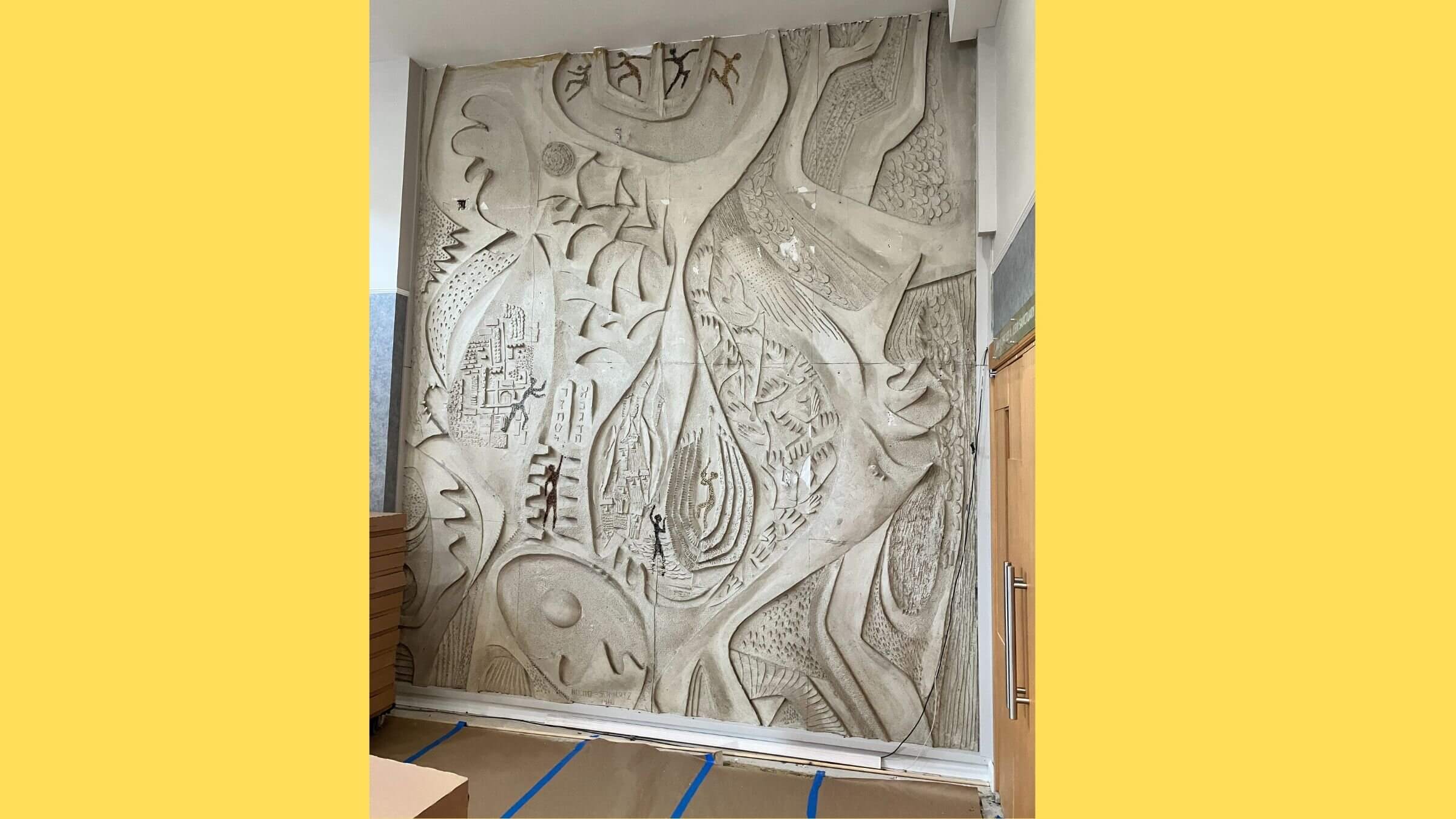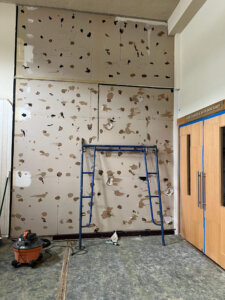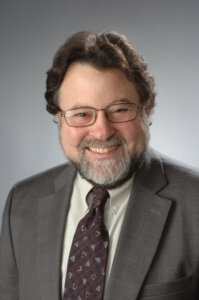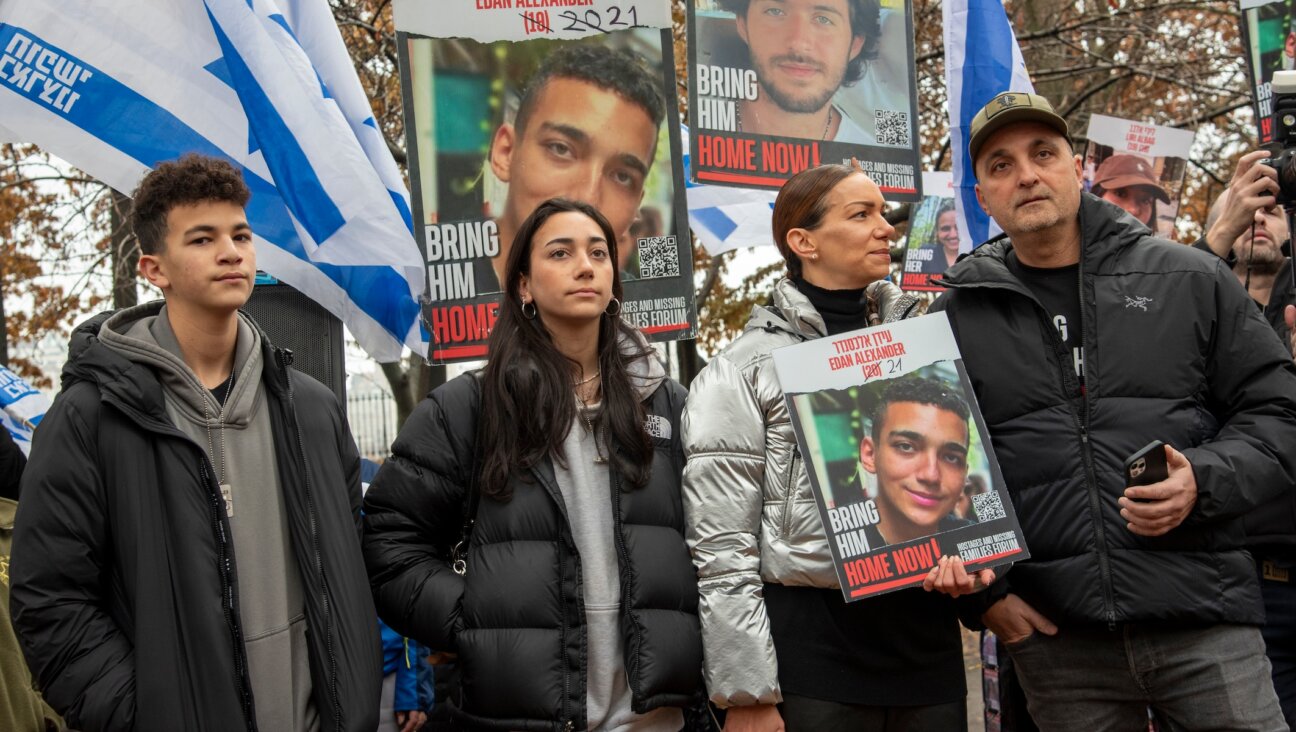A Long Island synagogue’s renovations uncover a massive work of art
At the High Holidays, many Merrick Jewish Centre congregants will get a first look at a forgotten treasure

The sculpture uncovered at the Merrick Jewish Centre in Merrick, New York Photo by Brad Kolodny

The massive mirrored wall in the lobby of the Merrick Jewish Centre struck many in the congregation as outdated. More than 14 feet high from floor to ceiling, and 12 feet wide, it worked for the Long Island synagogue when it was installed about three decades ago. Then it seemed modern, and gave the illusion of a much larger space.
But tastes change, and this spring, the congregation’s leaders, as part of a larger renovation project, decided to take the mirror down.
Behind it was a layer of sheetrock, and behind the sheetrock was a work of art some congregants did not know existed, and others had mostly forgotten.
“I was both stunned to see what we had been concealing for decades and confused as to why we permitted it to happen in the first place,” said synagogue president Howard Tiegel.
What was revealed was a relief sculpture, made primarily out of concrete, divided into 16 prefabricated sections, each depicting a three-dimensional abstract shape or a Jewish symbol.
Gray predominates, but the eight human figures — each posed climbing or reaching — are black or brown. There’s some damage in a few places where studs attached the sculpture to the sheetrock.

As the High Holidays approach, many of the synagogue’s 600 congregants will step into the freshly carpeted and wallpapered lobby, and get a first look at the 62-year-old sculpture.
They will likely wonder about the piece — who created it, and what will happen to it now. The first question is easier to answer.
Art history
At the bottom in the center the work is the creators’ signatures and the date it was made: “Nocito – Schwartz 1960.”
George Nocito was a sculptor and academic who came to prominence in the mid-20th century and specialized in bas relief. He died in 1977.
His partner in the Merrick Jewish Centre project was Bert Schwartz, who died in 1993 and whose kinetic works include “The Dancing Rabbi” and “The Judo Dancers.” One of his bronze sculptures, depicting six heads of President John F. Kennedy, each with a different facial expression, stood in front of a luxury Queens apartment building until Schwartz and residents in 1966 decided it was unsuitable for the site.

“Nocito and Schwartz drew on several 20th century artistic styles — symbolism, expressionism, and cubism – but have created something highly original” at the Merrick Jewish Centre, said Samuel Gruber, an American art and architectural historian who is president of the International Survey of Jewish Monuments, a nonprofit dedicated to conserving historic Jewish sites.
He called the work “unique,” and said it should be preserved. The generation after the generation that installed the sculpture likely found it dated, he said. “But the pendulum swings and there is now much interest and appreciation of the work of midcentury artists.”
Merrick Jewish Centre is just beginning to ponder the future of the artwork, which would be difficult to move. Its leaders plan to reach out to Gruber’s group and the Jewish Historical Society of Long Island for guidance.
Tiegel hopes the piece will be appreciated by the congregation as it was two generations ago.
“This art is part of the nearly 100-year history of our congregation and community and should be seen and restored in the days to come,” he said.
The Forward is free to read, but it isn’t free to produce

I hope you appreciated this article. Before you go, I’d like to ask you to please support the Forward.
Now more than ever, American Jews need independent news they can trust, with reporting driven by truth, not ideology. We serve you, not any ideological agenda.
At a time when other newsrooms are closing or cutting back, the Forward has removed its paywall and invested additional resources to report on the ground from Israel and around the U.S. on the impact of the war, rising antisemitism and polarized discourse.
This is a great time to support independent Jewish journalism you rely on. Make a gift today!
— Rachel Fishman Feddersen, Publisher and CEO
Support our mission to tell the Jewish story fully and fairly.
Most Popular
- 1

Fast Forward Ye debuts ‘Heil Hitler’ music video that includes a sample of a Hitler speech
- 2

Opinion It looks like Israel totally underestimated Trump
- 3

Fast Forward Student suspended for ‘F— the Jews’ video defends himself on antisemitic podcast
- 4

Culture Cardinals are Catholic, not Jewish — so why do they all wear yarmulkes?
In Case You Missed It
-

Fast Forward Hamas and Trump say Edan Alexander to be freed from Gaza after US negotiates release
-

Culture Should Diaspora Jews be buried in Israel? A rabbi responds
-

Fast Forward In first Sunday address, Pope Leo XIV calls for ceasefire in Gaza, release of hostages
-

Fast Forward Huckabee denies rift between Netanyahu and Trump as US actions in Middle East appear to leave out Israel
-
Shop the Forward Store
100% of profits support our journalism
Republish This Story
Please read before republishing
We’re happy to make this story available to republish for free, unless it originated with JTA, Haaretz or another publication (as indicated on the article) and as long as you follow our guidelines.
You must comply with the following:
- Credit the Forward
- Retain our pixel
- Preserve our canonical link in Google search
- Add a noindex tag in Google search
See our full guidelines for more information, and this guide for detail about canonical URLs.
To republish, copy the HTML by clicking on the yellow button to the right; it includes our tracking pixel, all paragraph styles and hyperlinks, the author byline and credit to the Forward. It does not include images; to avoid copyright violations, you must add them manually, following our guidelines. Please email us at [email protected], subject line “republish,” with any questions or to let us know what stories you’re picking up.















